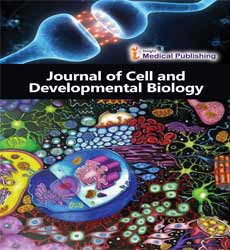The Process of Germination and Overall Growth and Development
Deepika Gupta*
Department of Biotechnology, Parul Institute of Applied Sciences, Parul University, Vadodara, India
- *Corresponding Author:
- Deepika Gupta
Department of Biotechnology, Parul Institute of Applied Sciences, Parul University, Vadodara, India
E-mail: janeru@ch.gmail.com
Received Date: November 05, 2021; Accepted Date: November 22, 2021; Published Date:November 30, 2021
Citation: Gupta D (2021) The Process of Germination and Overall Growth and Development. J Cell Dev Biol. Vol.5 No.6:18.
Opinion
Germination, the sprouting of a seed, spore, or different reproductive body, usually after a period of dormancy. The absorption of water, the passage of time, chilling, warming, oxygen availability, and mild exposure may all perform in initiating the process.
Within they prepare of seed germination, water is absorbed by the embryo, which results within the rehydration and expansion of the cells. Shortly after the beginning of water uptake, or imbibition, the fee of respiration increases, and various metabolic processes, suspended or much reduced during dormancy, resume. These events are related with structural changes in the organelles (membranous bodies concerned with metabolism), within the cells of the foetus.
Germination is usually the growth of a plant contained within a seed; it results in the formation of the seedling. It is also the process of reactivation of metabolic equipment of the seed resulting in the emergence of radicle and plumule. The seed of a vascular plant may be a little package created in a natural product or cone after the union of male and female reproductive cells. All fully advanced seeds contain an embryo and, in most plant species a few store of food reserves, wrapped in a seed coat. Some plants produce varying numbers of seeds that lack embryos; these are empty seeds which never germinate. Dormant seeds are viable seeds that do not germinate because they require specific inner or environmental stimuli to resume growth. Under right conditions, the seed starts to grow and the embryo resumes growth, creating into a seedling
Seed germination depends on both inside and outside conditions. The most crucial external factors include proper temperature, water, oxygen or air and sometimes light or darkness. Various plants require different variables for successful seed germination. Often this depends at the character seed variety and is intently linked to the ecological conditions of a plant's natural habitat. For some seeds, their destiny germination reaction is affected by environmental conditions during seed formation; most often those responses are varieties of seed dormancy.
The process of germination is as follows:
1. Environmental conditions are favorable: For germination to occur, the environmental conditions need to be favorable in order to assist the developing plant. The soil depth, sum of water, and temperature are all critical situations that must be met in arrange for the process of germination to be initiated. Typically, the soil conditions got to be moist and warm.
2. Water imbibition: When environmental conditions are optimal, germination is initiated by a process termed water imbibition. The seed retains water through a structure called a micropyle, which induces swelling of the seed until it parts open.
3. Root and Shoot formation: Once the seed has ruptured the radicle (primary root) and plumule (shoot) can rise from the seed. This process is initiated by specific enzymes that become activated when the seed is exposed to water. The roots develop downwards, and the shoot grows upwards towards the soil surface.
4. A seedling is formed: Once the shoot emerges from the soil surface, the cotyledons become absolutely unfolded and expand, eventually forming the first leaves. Once this occurs, the plant is ready to initiate photosynthesis and is considered a seedling.
Overall growth and development of a plant is regulated by complex interactions among various hormones, which is critical at different developmental stages. Some of the key factors of plant growth include seed development, germination and plant survival under unfavourable situations. Two of the important thing phyto hormones regulating the associated physiological processes are gibberellins (GA) and abscisic acid (ABA). GAs participate in numerous developmental processes, including, seed development and seed germination, seedling boom, root proliferation, determination of leaf size and shape, flower induction and development, pollination and fruit expansion. Despite the association with abiotic stresses, ABA is essential for regular plant growth and development. It plays a critical position in different abiotic stresses via way of means of regulating diverse downstream ABA-structured strain responses. Plants maintain a balance between GA and ABA levels constantly throughout the developmental processes at special tissues and organs, including under un favorable environmental or physiological conditions. Here, we will assess the writing on how GA and ABA control different levels of plant development, with focus on seed germination and chosen abiotic stresses. The possible crosstalk of ABA and GA in specific occasions of the above processes may also be discussed, with emphasis on downstream strain signaling components, kinases and transcription factors (TFs). The importance of several key ABA and GA signaling intermediates might be illustrated. The knowledge won from such studies will also assist to establish a solid basis to develop destiny crop improvement strategies.
Open Access Journals
- Aquaculture & Veterinary Science
- Chemistry & Chemical Sciences
- Clinical Sciences
- Engineering
- General Science
- Genetics & Molecular Biology
- Health Care & Nursing
- Immunology & Microbiology
- Materials Science
- Mathematics & Physics
- Medical Sciences
- Neurology & Psychiatry
- Oncology & Cancer Science
- Pharmaceutical Sciences
